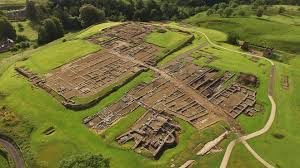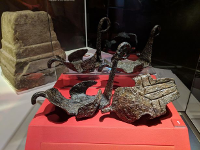|
Gameboard Found at U.K. Roman Ruins, Reused in Floor
May 6, 2019
Archaeologists at one of the United Kingdom's most celebrated Roman digs have unearthed a stone slab that they think was a game board in ancient times. The place is Vindolanda, a fort on Hadrian's Wall in what is now Northumberland that was a vibrant center of trade for about 400 years, ending in the 4th Century. Among the significant finds also chronicled at the Vindolanda site are the famed Vindolanda Letters, which include the oldest surviving Latin writing in a woman's hand, a party invitation. A volunteer digger found the piece of stone that was thought to have been a game board as part of a floor, in an example of repurposing. The floor is of a building behind the Vindolanda bath house, which has been newly excavated. The game was called Ludus latrunculorum, and it was played throughout the Roman Empire. It was a two-player game that challenged players to move different-colored pieces around the board, which would have been covered with a square grid. Trapping one of your opponent's pieces between two of your own results in your opponent's having to remove that piece. Whichever player captures all opposing pieces wins the game. Archaeologists have found similar game boards at the site, along with game pieces made of glass or stone. They have also, in 2017, found a new collection of the Letters. In a related development, a group of iron hipposandals found at Vindolanda in 2018 has gone on display at the Roman Army Museum at Carvoran. They are thought to have been used as horseshoes but could also have been used on donkeys, mules, and oxen. The idea of the hipposandal was to restrict the animal's movement, to keep it from straying. |
Social Studies for Kids |
Social Studies for Kids
copyright 2002–2024
David White






